The Telephone on P. E. I. - Switchboard /C.O./Service Equipment!
Member: Telephone Collector's International
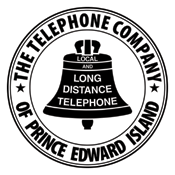 |
| |||||||||||||||
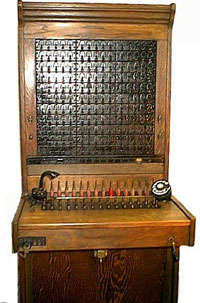 |
Tyne Valley Switchboard
Acting on a tip from one of our users, Joan Vermette, I checked out a local antique store, and was able to purchase this switchboard. It is the switchboard from the Tyne Valley exchange, an early Northern Electric 1240 board. This particular board is historically significant, as Tyne Valley was the last magneto exchange in the province to be converted to dial operation, this occurring on November 30th, 1977. During the board's restoration I didn't have the heart to remove the kids initials carved on the back of the desk top. They are part of its charm. Rusting on the drops forced repainting of them to prevent further deterioration. The dial which had been lost leaving only its mount following the closing of the exchange, has been replaced, as has the lower front door. Note on the left of the board shelf an early operator's breastplate microphone. This microphone was donated to the project by an old friend, Don Woodbury who runs a phone related business in Ontario.
|
In 1955, this switchboard was moved from Dr. Stewart's Drug Store in Tyne Valley, to the Royal Bank building, then 20 years later, to the home of the agent, Mrs. Eleanor (Birch) MacIntyre.On Dec. 5, 1977 the official opening of the new dial exchange was held, combined with a tribute to the retiring Mrs. Eleanor MacIntyre, and members of her staff, Miss Phyllis Milligan, Miss Pearl Williams, Miss Darlene Ellis, and Mrs. Arnold Gillis.
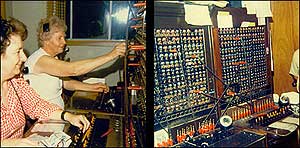
|
This photo of the magneto exchange was taken by Doris Gillis prior to the opening of the new dial exchange in 1977. Shown are agent Eleanor (Birch) MacIntyre (rear) and operator Phyllis Milligan (front) at its controls. The switchboard located to the left is the original and is shown above following restoration. In a recent telephone conversation, Phyllis told me that the dial on the board and the second board to the right were added to the exchange in the seventies, only years before it was decomissioned. |
If anyone has any other old P.E.I. switchboards, I would love to hear from them to exchange stories and information about them. After a long search, finally I have found one manual for the board, the March 14th, 1948 Northern Electric Bulletin No. 101, "Northern Electric 1240 Magneto Switchboard".
As a result of this manual, I now have the board fully operational, with lines identified, and several magneto phones attached to it. I can send and receive calls from the attached phones. This board has a maximum of 165 lines. It really wasn't difficult to set up, but having the manual gave me the courage to get back to it and get it working :-)
If anyone has any further bulletins or BSP's for this board, I would very much appreciate a photocopy of whatever information you have. It is my hope that other P.E.I. boards aside from this one have survived.
| Calculagraph Model 33
Calculagraphs were devices which operators used to keep a record of toll (long Distance) calls made by subscribers. The Model 33 Calculagraph consisted of an electric clock with a printing mechanism which printed the time on a toll ticket. It's synchronous motor is driven by an external 20 vac transformer. There was also a round wind up version which was used in great numbers across North America for call timing. A toll ticket would be inserted in the platen of the device (Toll ticket is actually shown upside down in this photo - it would be inserted so that the printing would be on front as shown below). To start timing, the right lever was pushed back, then pulled to the forward stop, marking the time of day face on the ticket, and starting the timer. To mark call completion time the left lever was pulled forward to its stop, leaving the elapsed time of the call in the form of minute and second pointers marked on the imprinted faces. This could then be kept as a permanent record for billing purposes. This instrument works 100% mechanically and electrically, but needs a setting key [View larger Photo]. Mine came without one. In 2001, Jeff Lamb began machining these keys and is making them available to collectors - contact him at:
View Copy of Calculagraph Manual A photo of a stamped toll card is shown below. The left hand dial shows the time of day of the call, the right hand dials, the elapsed minutes and seconds of the call. |
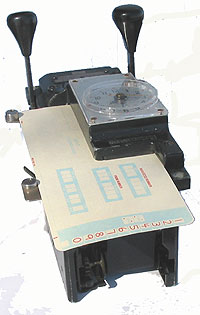 |
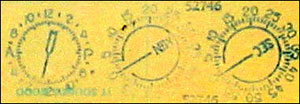
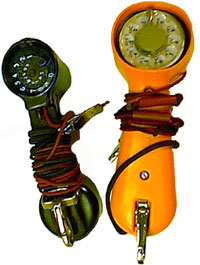 |
Linesmen's Butt Sets
Linesmen used a portable test phone in their daily job. These hung from the belt opposite the hand tools and became known as "Butt Sets", a reference to "Butting into the line". To the left are several in my collection. The black set to the top left is a hard rubber Western Electric Model 1011B telephone installer/repairperson's "butt set" test phone dating from the 1940's which incorporated an unusual "Pin" dial. In order to keep the dial size down (to about the size of a silver dollar), pins were placed beside each dial position to aid dialing. Each pin also had a small depression beside it to enable a mechanical pencil or other sharp instrument to be used alternatively for dialing. The actual dial numbering was set in the backing surrounding the moving portion of the dial.
The orange set on the top right is a GTE Automatic Electric Type 801 Model L9078-A1, dating from approximately 1970 until 1985 or so, and was issued within many independant telephone companies. Similar, but differently colored WECo 1013 or 1014 sets were used in most Regional Bells, I am told. |
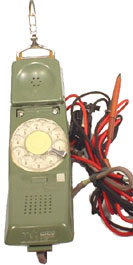 |
The 801 featured a mounting modified AE 154A dial with a sliding finger stop, similar in appearance to the dial on a Contempra phone but somewhat larger. Both sets above featured a test cord, monitor/talk switch, heavy-duty belt clip and a set of wire-piercing "bed of nails" alligator clips to connect to the lines. Both served the same purpose, the major differences being that the earlier was smaller but a little more difficult to dial, the latter easier to dial, but due to the larger dial, bulkier. Both, however were sturdy, surviving many years of active service resisting bumps, scrapes, and drops - insults which would kill any modern consumer device in short order.
To the lower left is a recent green Northern Telecom (Northern Electric) Central Office version butt set based upon the Contempra phone design. It is a model QSE4B2-76 set with Pat. Reg'd in 1967 - The "I&R" (Linesman's) version of the same phone without the changable cable and tools was the QSE4B1. As with other C. O. sets, it features an in-line plug and socket to which interchangable cord sets attach, allowing it to be used with different sets of cables for different uses.
|
| The QSE4B2 was designed for central office use, and the QSE4B1 was designed for use by linesmen. The cordset shown features a cord with what is known as a 360 tool at the end, with a 419A clip attached to it. This would be used to connect the lead to relay springs or switchhook springs, without shorting to the adjacent springs.The linesman's cord would terminate in "bed of nails" alligator clips as the sets above do. With this interchangability, this was a very versatile instrument. Much of this information and much of the background information on other butt sets courtesy of Steph Kerman, one of the many very helpful and knowledgable members of the telephone collecting community. |
Telephone Tools:This is a very small selection of tools in my collection. A full list of the hundreds of tools in the collection may be viewed at: tools_switching.pdf.
| 1. Arrow T-18 wire stapler, shooting a special rounded staple
designed for stapling cable up to 3/16" dia. (a T-25 stapler would be used for
larger cable). 2. ATI Ind. 1468-3 tool designed for removing stuck mouth and earpieces from G type handsets. 3. Yankee push drill. 4. Homs 187S 7-digit number stamper, designed to stamp telephone number cards. 5. W.E. KS-2348 Pin guided screwdriver. 6. WE 553A swithchboard bulb remover. 7. W.E. KS-16750 L4 dial finger wheel removal tool. 8. Harris Corp. Can Wrench. |
 |
The telephone industry has produced many specialty tools custom designed specifically for each application. Another tool which can be exceedingly useful, is a small strap wrench (not shown) such as Sears and Canadian Tire sell. Northern Electric actually had its own version of a strap wrench, the 514A designed for removing stubborn caps from handsets. It is a better option than the 1468-3 (#2) shown above, for this purpose. This is only a very small sampling of the tools in the current collection.
Special tools designed included wire management tools of various descriptions, contact adjusters, burnishers, other handset tools, and spring adjusters, and many other tools for more obscure purposes. I will never have a complete collection, but those shown here will give you an idea of the wide variety which were used. Even among experienced tool collectors, it is often a guessing game to try to figure out what in particular some specialty phone tools were designed for, but I have been able to locate PDF copies of several vintage tool catalogues which have aided me with identification. My tool collection now amounts to over 140 original specialized tools and test instruments, including those designed for central office use, Strowger step by step, teletype servicing, and for outside plant use. I continue looking for more to add to the tool collection which first began with the few items above. Collecting these alone is an interesting hobby! For more tool listings, see tools_switching.pdf.
| This is the toolbox the tools above are stored in. It is a vintage Bell System "Small Installers Case" type "B" I acquired recently. New information places its manufacture date to pre 1961. It can be dated at that time since it has a leather handle. More recent versions of this case came with non-leather handles. It contains a storage tray under the lid, which removes to expose storage compartments below This box measures 16" wide, x 10" high, and is 7.5" deep. Box shown following restoration with Bell System logo chalked to show in photo. Thanks John for the new information! |
 |
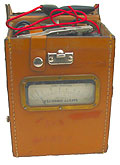
|
Megger A megger is a form of ohmmeter used to check the insulation and resistance of lines. The test voltage was generated through the use of a magneto cranked at the top. This instrument could be very useful diagnosing line problems in the early days! There are more sophisticated devices for this purpose available now such as the 145A above, but this was the good old standby in the not so distant past. I have had this unit since the mid-80's. |
| Western
Electric 145A Test Set
This test set was used to test subscriber lines from the customer premises, generally after repairs were made. It measures Volts, Ohms, loop current, loss, as well as balance, power influence, and circuit noise (these were measured in reference to the "quiet line" in the CO) the 145 also had a footage or "feet" function that served as a rough open locator in one position and a resistive fault locator when corrected for conductor gauge and temperature. It also includes a tone function. |
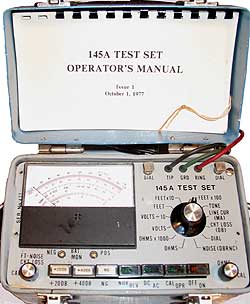
|

|
AT-8629 Test Probe (left) - used in conjunction with the WE-145A to conduct pair identification using the tones generated by the set. Often called a banana. A butt set was clipped to the probe, and proximity to the wire fed with the tone would give an audible indication, allowing it to be easily identified. This tool is powered by an Eveready 206, NEDA 1611 - 9 volt tubular battery, The probe comes with two interchangeable probe tips, and a leather scabbard designed for keeping the tool on one's belt (not shown). |
|
 |
| 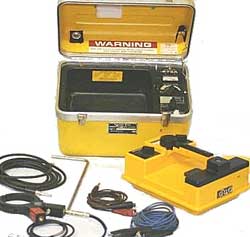 |
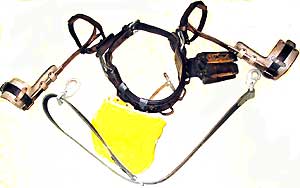 |
|
Telephone Line Construction and Insulators:
A lot of the younger generation think telephone lines were always a nice neat single thick wire on a pole; others are familiar only with underground installations or cell. Heck, who needs wires! Err, weren't phones always cordless?
Fact is, until the mid century, telephone lines consisted of open wire lines. Each line consisted of single conductor wires, individually held atop the pole by a cross-arm and insulators. Each cross-arm would hold multiple lines, and each pole could hold multiple cross-arms. According to C.S.A. specification 0116-1953 published in the Northern Electric T8 catalogue, there were 12 standard designs, ranging from 1'7" to 10' in length, and supporting 2 to 16 conductors. If more conductors than this were required, multiple cross-arms were ganged on the same pole. Often insulators were supported from the pole using wooden side brackets and no crossarm, two to a pole (duplex). [Site showing duplex installation] - These brackets were generally used where the run was for a single line only.
Insulators shown on the collection's vintage cross-arm in the photo above (L to R) - Hemingray #9 pony in aqua (CD-106); Brookfield baby pony in lt. aqua, smaller than #9, measures 2 1/8 x 3.5" (similar to CD-102); Dominion #42 lt. peach (CD-154); Dominion #42 lt. peach (CD-154); Dominion #9 pony in clear (CD-108); and finally another Hemingray #9 pony in aqua (CD-106) Also found was an interesting Brookfield "B" insulator in dark green (CD-145) and 3 Hemingray C.S.C. insulators (CD-128); also one Armstrong C.S.C. (CD-128) [all slightly off-clear with a smoky tint, particularly the Armstrong - not shown here as the C.S.C.'s use a smaller steel mounting pin and a lead sleeve - I do not have a mount suitable for them]. As far as the CD numbers, they are as correct as I can get them as per net searches - perhaps an insulator collector might be able to confirm or correct the numbers given. From time to time I will change the insulators on the arm to present the ceramic insulator I have, also those donated by Irene and Jim, and to show the "B". When not displayed on the arm, they will be displayed separately on extra pins I purchased.
The wooden portion of the arm and the metal attachments (not shown), but minus pins and insulators, were saved many years ago by Bernie MacIntyre who had planned to use it for a fence post - thankfully, he never got around to using it. Meanwhile, it was kept in good, dry storage, which kept it in remarkable condition. The cross-arm would be bolted through the pole using the center hole, then metal braces would run from the holes adjacent to the second from the left and second from the right pins downwards to bolt to the pole below the cross-arm. You will still see the same mounting arrangement on the 3 phase electrical poles of today.
Various donations and purchases have made this cross-arm project possible. It has been many years since this type of cross-arm has been used in the telephone system, and these parts are getting very hard to track down. Thanks to Bernie for donating the cross-arm and braces, Irene and Jim McNeil, who donated three porcelain insulators; and to Leo MacDonald, who donated the two Dominion #42 light peach glass insulators towards the project. I previously had one #614 porcelain insulator, and found a number of glass insulators at an antique shop near Summerside thanks to a tip from Bernie. It was a real group effort. Finding the wooden insulator support pins for the cross-arm was difficult, as the last known maker of these pins, May & Bigley, in Bedford, P.A. shut down in 1998. These I finally found and purchased from a gentleman in Oregon. These pins, threaded at one end to accept the insulator thread, fit at the other end into 1 ¼" holes on the cross-arm.
Insulators, by themselves are an interesting subject. The early ones were made of glass, and later porcelain. Canada's largest manufacturer of glass insulators was the Dominion Glass Company Ltd. of Wallaceburg, Ontario. I hope to eventually display a range of different types and colours of glass insulators on the arm. If you have some coloured glass insulators you would be willing to have displayed on the cross-arm, please let me know - of course, I will also be on the lookout here. These insulators today are the subject of dedicated collections - with their varied colours and shapes, they could be very beautiful! I don't profess to be an expert on the subject of insulator collecting. My sole purpose here is to display an old open-wire cross-arm for those who might not have seen one otherwise.
Note: January 15, 2007. I have a mystery. This morning in the mail, I received a package in the mail from a T. Vaughn from Phoenix, Arizona. I wasn't expecting this at all. It contained a 1969 issue of the very interesting book, "The Collector's Guide for Glass Insulators", by Cranfill and Kareofelas. Thanks to T. Vaughn for this book. I wish I knew exactly who you were or had an email address so that I could properly thank you!
Why do people think insulators are so beautiful - to the extent they have been called the "Crown Jewels of the Wire"? Have a look at a recently acquired Diamond Glass Co. of Montreal (which became Dominion Glass Co. in 1913) purple CD-102 pony (right).
This has become my favorite insulator. Incidentally, most of the insulators shown above are every bit as beautiful when photographed with light in the background this way !
Below is a listing of some of the more commonly used types of insulators from the Northern Electric T7 Catalogue. Terms used with regard to insulators that you might find puzzling, are the references to "petticoats" on an insulator, and to the reference calling some insulators "Pony".
- Petticoat: (n.) - Describes the # of skirts on an insulator, as in double petticoat. Those with more petticoats would present a longer path for electrical leakage.
- Pony: (n.) - Nickname for a number of smaller styles of insulators (as in #9).
|
Number
|
Insulator Description and Common
Useage - View
photos from Northern Electric T7 Catalogue
|
| #9 | Single groove, single petticoat pony. Light weight type for rural lines. |
| #16 | Single groove, single petticoat with very long leakage path, used most often for toll lines. |
| #22 | Single square groove, single petticoat for long distance carrier circuits. |
| #42 | One of the more common types: - Double petticoat, square groove, for telephone and telegraph long line construction. |
| #53 | Double Groove, single petticoat, one piece transposition on rural circuits. |
| #56 | Triple groove, single petticoat, for point transposition on rural circuits. |
| #614 | Extra deep groove, double petticoat for heavy circuits, mostly long line. |
I am always looking for other old P.E.I. phone paraphenalia to add to this collection. I hope it one day it will become a truly representative collection of the phones used on P.E.I., and that through it a large portion of P.E.I.'s telephone history can be saved for posterity.
I keep finding the odd piece in the most unexpected places! If anyone here on the Island knows of any stash of old phone parts (cords, dials, handsets, manuals, ringers, insulators, or whatever), specialty tools, service or owner's manuals for any telephone equipment, or has any old broken, disassembled, or damaged phones (pre-1990) or parts thereof, please let me know - even if they look useless, their parts might be of real help to repair and maintain items in the collection. Also, I would love to make contact with other telephone collectors here on the Island to share experiences and knowledge!
Dave Hunter, [email protected]